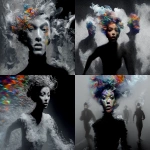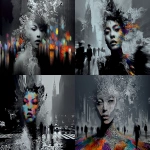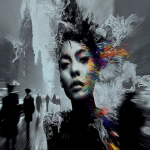Explore the Best AI Image Gallery

Beyond the Brush: Wearable Tech as a Creative Canvas
The world of creativity has been irrevocably altered by advancements in wearable technology.
From smart glasses that augment reality to haptic suits that translate touch into digital experiences, these innovations are blurring the lines between the physical and digital realms, empowering artists to express themselves in unprecedented ways.
Wearables Redefining Artistic Expression
Traditionally, creative expression has been confined to physical tools like brushes, chisels, or musical instruments. Wearable technology is dismantling these limitations, offering artists a new set of tools to interact with their art and engage audiences in immersive ways.
- Augmented Reality (AR) Glasses: AR glasses can overlay digital elements onto the real world, allowing artists to paint on virtual canvases that blend seamlessly with their surroundings. Imagine sculpting a 3D masterpiece that appears to float in mid-air or creating interactive murals that respond to viewer movement.
- Haptic Suits: These suits translate touch into digital signals, enabling artists to “feel” the texture of virtual objects or even experience the vibrations of a musical performance. This tactile dimension can create a deeper connection between the artist and their work, as well as between the artist and the audience.
- Motion Capture Technology: Wearable sensors can capture an artist’s movements with incredible accuracy, translating them into digital animations or performances. Imagine dancers choreographing intricate routines in a virtual space, their movements reflected in stunning holographic projections.
The Creative Industry Embraces the Shift
The impact of wearable technology extends beyond individual artists; it’s reshaping entire industries:
- Fashion Design: Wearable sensors can track body movements and adjust clothing patterns in real time, creating garments that adapt to the wearer’s needs.
- Gaming and Entertainment: Immersive gaming experiences fueled by haptic suits and AR technology are blurring the lines between reality and fantasy.
- Architecture and Design: Wearable devices can allow architects and designers to visualize their creations in 3D, making it easier to collaborate and iterate on designs.
Ethical Considerations in a New Creative Landscape
As wearable technology becomes more integrated into the creative process, it raises important ethical considerations:
- Data Privacy: Wearable devices collect vast amounts of personal data. It’s crucial to ensure that this data is used responsibly and ethically.
- Accessibility: The cost of wearable technology can create a barrier to entry for some artists. It’s important to strive for inclusivity and make these tools accessible to all.
- Authenticity and Ownership: As AI-powered tools become more sophisticated, questions arise about the authenticity of art created with their assistance. Who owns the copyright to works generated by AI?
The Future of Creativity: A Wearable Horizon
The future of creativity is undoubtedly intertwined with wearable technology. As these devices evolve, we can expect even more innovative applications that push the boundaries of artistic expression:
- Brain-Computer Interfaces (BCIs): Imagine artists controlling virtual worlds or creating art with their thoughts.
- Biometric Sensing: Wearables could capture an artist’s emotional state and translate it into their work, adding a new layer of depth and meaning.
- Personalized Creative Experiences: Wearable technology could tailor artistic experiences to individual preferences, creating truly immersive and unique interactions.
Wearable technology is not just a tool; it’s a transformative force reshaping the very definition of creativity. As we embrace this new frontier, its essential to navigate the ethical challenges thoughtfully and ensure that these technologies empower artists and foster a more inclusive and innovative creative landscape.






](https://images.ai-img.art/thumbnails/150/a3ed6513a6661aa3ee46e0c2924d1e8888854e91d8908de39db5590dc41f8d8f.webp)











](https://images.ai-img.art/thumbnails/150/ff09e32d2be011c0dd785984c5c1e47839ce551a31da1bde242860b30df2aa30.webp)
](https://images.ai-img.art/thumbnails/150/bd056a4718c27444e064198762f8dc8ffa1f74f1afd7dcda8d5cb8b142797d6e.webp)


](https://images.ai-img.art/thumbnails/150/685ae68cfab93a7e59a71206867b060c45bd6fd3cd561c4fe60fca514b09c5f8.webp)
](https://images.ai-img.art/thumbnails/150/0ba0be922ab76af53f75ab90126ae2b18a600ee3b96941e8ab897a9f10594e5a.webp)



](https://images.ai-img.art/thumbnails/150/7cf5a08238f29c821f52bb4f63db48af0b7f633ff3b9f7253074d78ced9ff6f6.webp)




](https://images.ai-img.art/thumbnails/150/2ebdeb4f7db35100e5be5de9bc3e533a40d14e5feedefd7ffc586524a0f3ba8c.webp)












](https://images.ai-img.art/thumbnails/150/847809c77ca9a73b68bc190e6efb06fec87157685a243730d5a66a403b0e6e10.webp)



